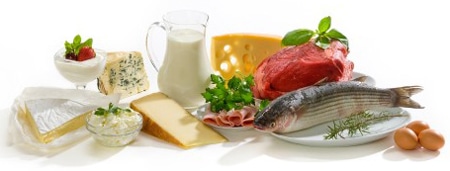3 Simple Tips on Feeling Comfortably Full + Satiated Longer
Tip One: Eat what you are craving and enjoy it mindfully. If we ignore our cravings, we typically end up eating almost everything in site. Craving that slice of chocolate cake? Honor your craving or else you might go back and eat the whole darn cake. I’ve been there myself. Live and learn!
Tip Two: Eat protein with most of your meals + snacks. Protein takes longer to digest than carbohydrates, helping us feel fuller longer while also keeping blood sugar levels steady. Aim for 15-20 grams of protein at breakfast and about an open-palm size portion of protein at lunch and dinner. When you snack, go for that fiber-carbohydrate-protein mix. A few snack examples include the following:
*Apple with organic peanut butter or sun butter
*Slice of whole grain bread (Ezekiel’s cinnamon raisin is one of my favorites) with almond butter
*Single serving of yogurt such as Chobani, siggi’s, or my new fav noosa with slivered almonds or dark chocolate chips on top
*Pear with a cheddar cheese stick
*Handful of veggies dipped in your favorite flavor of hummus
How much protein do we need?
Around 10-35% of our daily caloric intake should come from protein. On average, healthy adults need 0.4 grams of protein per pound of body weight. Athletes, pregnant or lactating women, and those with specialized nutrition needs will have higher needs.
Not all protein is created equal though, so be sure to choose high-quality proteins without added sodium and unnecessary saturated or trans fats. I always encourage variety including leaner animal sources such as fish, poultry without the skin, 90% lean ground beef, eggs, dairy sources such as yogurt, milk, and cheese, and plant-based sources such as quinoa, beans, lentils, nuts, organic tofu and tempeh.
Tip 3: Fill up on fiber and hydrate! Fiber adds volume and bulk to the stomach, stimulating fullness faster while also slowing down the rate of digestion. For example, you’re more likely to feel full after eating (one of my favs!) avocado on whole grain toast versus a piece of white toast and jelly.
The effects of fiber are even better when consumed with a glass of water, which absorbs and “bloats” soluble fibers creating even more volume and fullness in the stomach. Make sure to include a handful of fiber-rich foods such as whole grains, fresh fruits and veggies, beans, peas, and lentils into your daily lifestyle.
Think you are hungry? You might actually be dehydrated. Drinking plenty of water can actually signal satiety and curb hunger. How? The lining of our stomach is full of nerve cells that signal to the brain “I’m full!” when the stomach has been filled to a certain point.
The next time you think you feel hunger pains, take a drink of water and then determine if you still physically feel hungry. Not a fan of plain water? Spice up your water by adding fresh citrus or herbs. My all time favorite is good ole’ lemon water.

Chrissy Barth
MS RDN RYT
The EPIC Biology sports nutrition blog is a resource for athletes of all ages. If you’re looking to gain a competitive advantage by optimizing your performance and improving overall wellness, you’ve come to the right place.
Unlock Your Body’s Potential EVERY DAY
Ready to ask yourself crucial questions about your health every day? We’ll help you knock it out of the park with a simple, easy-to-use checklist.
Ready to take your performance to the next level?
I’m here to help.
If you’re looking for individualized, sustainable sports nutrition guidance, let’s chat. Schedule a free 15-minute call so that we can get to know each other, then establish your next steps.
Tip One: Eat what you are craving and enjoy it mindfully. If we ignore our cravings, we typically end up eating almost everything in site. Craving that slice of chocolate cake? Honor your craving or else you might go back and eat the whole darn cake. I’ve been there myself. Live and learn!
Tip Two: Eat protein with most of your meals + snacks. Protein takes longer to digest than carbohydrates, helping us feel fuller longer while also keeping blood sugar levels steady. Aim for 15-20 grams of protein at breakfast and about an open-palm size portion of protein at lunch and dinner. When you snack, go for that fiber-carbohydrate-protein mix. A few snack examples include the following:
*Apple with organic peanut butter or sun butter
*Slice of whole grain bread (Ezekiel’s cinnamon raisin is one of my favorites) with almond butter
*Single serving of yogurt such as Chobani, siggi’s, or my new fav noosa with slivered almonds or dark chocolate chips on top
*Pear with a cheddar cheese stick
*Handful of veggies dipped in your favorite flavor of hummus
How much protein do we need?
Around 10-35% of our daily caloric intake should come from protein. On average, healthy adults need 0.4 grams of protein per pound of body weight. Athletes, pregnant or lactating women, and those with specialized nutrition needs will have higher needs.
Not all protein is created equal though, so be sure to choose high-quality proteins without added sodium and unnecessary saturated or trans fats. I always encourage variety including leaner animal sources such as fish, poultry without the skin, 90% lean ground beef, eggs, dairy sources such as yogurt, milk, and cheese, and plant-based sources such as quinoa, beans, lentils, nuts, organic tofu and tempeh.
Tip 3: Fill up on fiber and hydrate! Fiber adds volume and bulk to the stomach, stimulating fullness faster while also slowing down the rate of digestion. For example, you’re more likely to feel full after eating (one of my favs!) avocado on whole grain toast versus a piece of white toast and jelly.
The effects of fiber are even better when consumed with a glass of water, which absorbs and “bloats” soluble fibers creating even more volume and fullness in the stomach. Make sure to include a handful of fiber-rich foods such as whole grains, fresh fruits and veggies, beans, peas, and lentils into your daily lifestyle.
Think you are hungry? You might actually be dehydrated. Drinking plenty of water can actually signal satiety and curb hunger. How? The lining of our stomach is full of nerve cells that signal to the brain “I’m full!” when the stomach has been filled to a certain point.
The next time you think you feel hunger pains, take a drink of water and then determine if you still physically feel hungry. Not a fan of plain water? Spice up your water by adding fresh citrus or herbs. My all time favorite is good ole’ lemon water.

